简易版的Spring框架之AOP简单实现(对我来说不简单啊)
- 支持singleton类型的bean,包括初始化、属性注入、以及依赖bean注入。
- 可从xml中读取配置。
- 可以使用Aspectj的方式进行AOP编写,支持接口和类代理。
说明
如果你有幸能看到
- 1、本文简易Spring框架参考 Github ,代码注释参考 Github .
- 2、所有权归原作者,在这里自己只是临摹,参考注释还原过程。不懂的可以看作者的视频。
- 3、大家一起努力,一起学习,有兴趣的也可以看下我的 Github 。上传了Spring源码。大佬可以看看。
- 4、看本文之前希望你有一份Spring源码。对照着找你想要的接口和类。加深印象。
- 5、本文只为自己以后复习用,如果不对还请谅解。
tiny-spring 是为了学习Spring的而开发的,可以认为是一个Spring的精简版。Spring的代码很多,层次复杂,阅读起来费劲。我尝试从使用功能的角度出发,参考Spring的实现,一步一步构建,最终完成一个精简版的Spring。 有人把程序员与画家做比较,画家有门基本功叫临摹,tiny-spring可以算是一个程序的临摹版本-从自己的需求出发,进行程序设计,同时对著名项目进行参考。
第二部分:AOP及实现
AOP分为配置(Pointcut,Advice),织入(Weave)两部分工作,当然还有一部分是将AOP整合到整个容器的生命周期中。
7.step7-使用JDK动态代理实现AOP织入
织入(weave)相对简单,我们先从它开始。Spring AOP的织入点是AopProxy,它包含一个方法Object getProxy()来获取代理后的对象。
在Spring AOP中,我觉得最重要的两个角色,就是我们熟悉的MethodInterceptor和MethodInvocation(这两个角色都是AOP联盟的标准),它们分别对应AOP中两个基本角色:Advice和Joinpoint。Advice定义了在切点指定的逻辑,而Joinpoint则代表切点
切点通知器相关接口
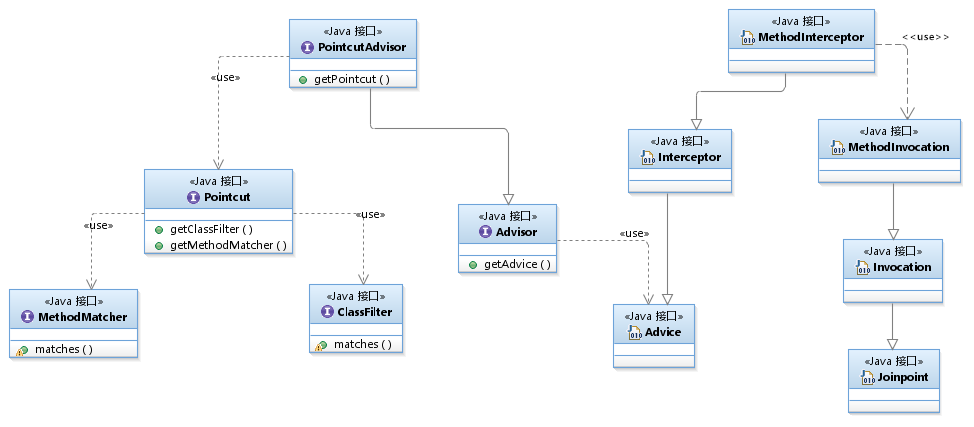
public interface MethodInterceptor extends Interceptor {
Object invoke(MethodInvocation invocation) throws Throwable;
}
Spring的AOP只支持方法级别的调用,所以其实在AopProxy里,我们只需要将MethodInterceptor放入对象的方法调用即可。
使用jdk动态代理
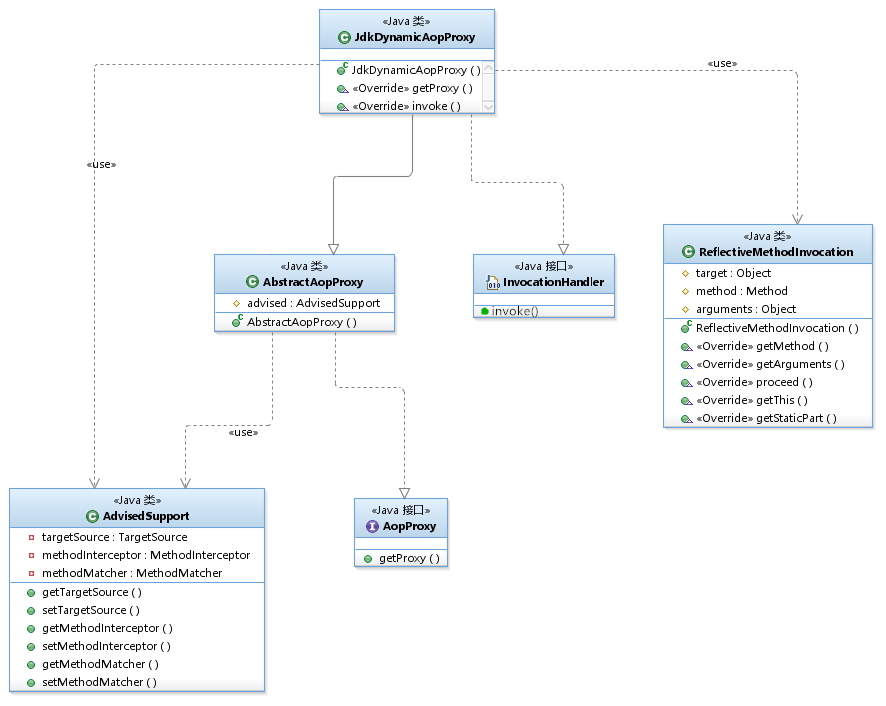
public class JdkDynamicAopProxy extends AbstractAopProxy implements InvocationHandler {
public JdkDynamicAopProxy(AdvisedSupport advised ) {
super(advised);
}
@Override
public Object getProxy() {
return Proxy.newProxyInstance(getClass().getClassLoader(),advised.getTargetSource().getInterfaces(),this);
}
@Override
public Object invoke(Object proxy, Method method, Object[] args) throws Throwable {
//提取拦截的方法
MethodInterceptor methodInterceptor = (MethodInterceptor) advised.getMethodInterceptor();
//比较传入的方法和对象的方法是否一致,如果一致则调用传入的方法,
if (advised.getMethodMatcher() != null
&& advised.getMethodMatcher().matches(method, advised.getTargetSource().getTarget().getClass())) {
//这里应该是先调用拦截的方法,然后调用原始对象的方法。但是一般括号里的东西不是优先吗?括号里面好像就只有赋值操作而已。
return methodInterceptor.invoke(new ReflectiveMethodInvocation(advised.getTargetSource().getTarget(),method, args));
} else {
return method.invoke(advised.getTargetSource().getTarget(), args);
}
}
我们称被代理对象为TargetSource,而AdvisedSupport就是保存TargetSource和MethodInterceptor的元数据对象。这一步我们先实现一个基于JDK动态代理的JdkDynamicAopProxy,它可以对接口进行代理。于是我们就有了基本的织入功能。
@Test
public void testInterceptor() throws Exception {
// --------- helloWorldService without AOP
ApplicationContext applicationContext = new ClassPathXmlApplicationContext("tinyioc.xml");
HelloWorldService helloWorldService = (HelloWorldService) applicationContext.getBean("helloWorldService");
helloWorldService.helloWorld();
// --------- helloWorldService with AOP
// 1. 设置被代理对象(Joinpoint)
AdvisedSupport advisedSupport = new AdvisedSupport();
TargetSource targetSource = new TargetSource(helloWorldService, HelloWorldServiceImpl.class,
HelloWorldService.class);
advisedSupport.setTargetSource(targetSource);
// 2. 设置拦截器(Advice)
TimerInterceptor timerInterceptor = new TimerInterceptor();
advisedSupport.setMethodInterceptor(timerInterceptor);
// 3. 创建代理(Proxy)
JdkDynamicAopProxy jdkDynamicAopProxy = new JdkDynamicAopProxy(advisedSupport);
HelloWorldService helloWorldServiceProxy = (HelloWorldService) jdkDynamicAopProxy.getProxy();
// 4. 基于AOP的调用
helloWorldServiceProxy.helloWorld();
}
8.step8-使用AspectJ管理切面
git checkout step-8-invite-pointcut-and-aspectj
完成了织入之后,我们要考虑另外一个问题:对什么类以及什么方法进行AOP?对于“在哪切”这一问题的定义,我们又叫做“Pointcut”。Spring中关于Pointcut包含两个角色: ClassFilter 和 MethodMatcher ,分别是对类和方法做匹配。Pointcut有很多种定义方法,例如类名匹配、正则匹配等,但是应用比较广泛的应该是和 AspectJ 表达式的方式。
AspectJ 是一个“对Java的AOP增强”。它最早是其实是一门语言,我们跟写Java代码一样写它,然后静态编译之后,就有了AOP的功能。下面是一段AspectJ代码:
aspect PointObserving {
private Vector Point.observers = new Vector();
public static void addObserver(Point p, Screen s) {
p.observers.add(s);
}
public static void removeObserver(Point p, Screen s) {
p.observers.remove(s);
}
...
}
这种方式无疑太重了,为了AOP,还要适应一种语言?所以现在使用也不多,但是它的 Pointcut 表达式被Spring借鉴了过来。于是我们实现了一个 AspectJExpressionPointcut :
@Test
public void testMethodInterceptor() throws Exception {
String expression = "execution(* us.codecraft.tinyioc.*.*(..))";
AspectJExpressionPointcut aspectJExpressionPointcut = new AspectJExpressionPointcut();
aspectJExpressionPointcut.setExpression(expression);
boolean matches = aspectJExpressionPointcut.getMethodMatcher().matches(HelloWorldServiceImpl.class.getDeclaredMethod("helloWorld"),HelloWorldServiceImpl.class);
Assert.assertTrue(matches);
}
public class AspectJExpressionPointcutTest {
@Test
public void testClassFilter() throws Exception {
String expression = "execution(* us.codecraft.tinyioc.*.*(..))";
AspectJExpressionPointcut aspectJExpressionPointcut = new AspectJExpressionPointcut();
aspectJExpressionPointcut.setExpression(expression);
boolean matches = aspectJExpressionPointcut.getClassFilter().matches(HelloWorldService.class);
Assert.assertTrue(matches);
}
@Test
public void testMethodInterceptor() throws Exception {
String expression = "execution(* us.codecraft.tinyioc.*.*(..))";
AspectJExpressionPointcut aspectJExpressionPointcut = new AspectJExpressionPointcut();
aspectJExpressionPointcut.setExpression(expression);
boolean matches = aspectJExpressionPointcut.getMethodMatcher().matches(HelloWorldServiceImpl.class.getDeclaredMethod("helloWorld"),HelloWorldServiceImpl.class);
Assert.assertTrue(matches);
}
9.step9-将AOP融入Bean的创建过程
git checkout step-9-auto-create-aop-proxy
万事俱备,只欠东风!现在我们有了Pointcut和Weave技术,一个AOP已经算是完成了,但是它还没有结合到Spring中去。怎么进行结合呢?Spring给了一个巧妙的答案:使用 BeanPostProcessor 。
BeanPostProcessor是BeanFactory提供的,在Bean初始化过程中进行扩展的接口。只要你的Bean实现了 BeanPostProcessor 接口,那么Spring在初始化时,会优先找到它们,并且在Bean的初始化过程中,调用这个接口,从而实现对BeanFactory核心无侵入的扩展。
那么我们的AOP是怎么实现的呢?我们知道,在AOP的xml配置中,我们会写这样一句话:
<aop:aspectj-autoproxy/>
它其实相当于:
<bean id="autoProxyCreator" class="org.springframework.aop.aspectj.autoproxy.AspectJAwareAdvisorAutoProxyCreator"></bean>
AspectJAwareAdvisorAutoProxyCreator 就是AspectJ方式实现织入的核心。它其实是一个BeanPostProcessor。在这里它会扫描所有Pointcut,并对bean做织入。
为了简化xml配置,我在tiny-spring中直接使用Bean的方式,而不是用aop前缀进行配置:
<bean id="autoProxyCreator" class="us.codecraft.tinyioc.aop.AspectJAwareAdvisorAutoProxyCreator"></bean>
<bean id="timeInterceptor" class="us.codecraft.tinyioc.aop.TimerInterceptor"></bean>
<bean id="aspectjAspect" class="us.codecraft.tinyioc.aop.AspectJExpressionPointcutAdvisor">
<property name="advice" ref="timeInterceptor"></property>
<property name="expression" value="execution(* us.codecraft.tinyioc.*.*(..))"></property>
</bean>
TimerInterceptor 实现了 MethodInterceptor (实际上Spring中还有 Advice 这样一个角色,为了简单,就直接用MethodInterceptor了)。
至此,一个AOP基本完工。
10.step10-使用CGLib进行类的织入
git checkout step-10-invite-cglib-and-aopproxy-factory
前面的JDK动态代理只能对接口进行代理,对于类则无能为力。这里我们需要一些字节码操作技术。这方面大概有几种选择: ASM , CGLib 和 javassist ,后两者是对 ASM 的封装。Spring中使用了CGLib。
在这一步,我们还要定义一个工厂类 ProxyFactory ,用于根据TargetSource类型自动创建代理,这样就需要在调用者代码中去进行判断。
另外我们实现了 Cglib2AopProxy ,使用方式和 JdkDynamicAopProxy 是完全相同的。
public class Cglib2AopProxy extends AbstractAopProxy {
public Cglib2AopProxy(AdvisedSupport advised) {
super(advised);
}
//通过cglib类库创建了一个代理类的实例
@Override
public Object getProxy() {
Enhancer enhancer = new Enhancer();
enhancer.setSuperclass(advised.getTargetSource().getTargetClass());
enhancer.setInterfaces(advised.getTargetSource().getInterfaces());
//设置代理类的通知方法,相当于设置拦截器方法
enhancer.setCallback(new DynamicAdvisedInterceptor(advised));
Object enhanced = enhancer.create();
return enhanced;
}
//方法拦截器
private static class DynamicAdvisedInterceptor implements MethodInterceptor {
private AdvisedSupport advised;
private org.aopalliance.intercept.MethodInterceptor delegateMethodInterceptor;
private DynamicAdvisedInterceptor(AdvisedSupport advised) {
this.advised = advised;
this.delegateMethodInterceptor = advised.getMethodInterceptor();
}
//调用代理类的方法(代理类与原始类是父子关系,还有一种是兄弟关系,调用实质是调用原始类的方法)
@Override
public Object intercept(Object obj, Method method, Object[] args, MethodProxy proxy) throws Throwable {
if (advised.getMethodMatcher() == null
|| advised.getMethodMatcher().matches(method, advised.getTargetSource().getTargetClass())) {
//这里也应该是先调用拦截方法,然后调用原始对象的方法
return delegateMethodInterceptor.invoke(new CglibMethodInvocation(advised.getTargetSource().getTarget(), method, args, proxy));
}
return new CglibMethodInvocation(advised.getTargetSource().getTarget(), method, args, proxy).proceed();
}
}
private static class CglibMethodInvocation extends ReflectiveMethodInvocation {
private final MethodProxy methodProxy;
public CglibMethodInvocation(Object target, Method method, Object[] args, MethodProxy methodProxy) {
super(target, method, args);
this.methodProxy = methodProxy;
}
@Override
public Object proceed() throws Throwable {
return this.methodProxy.invoke(this.target, this.arguments);
}
}
有一个细节是CGLib创建的代理是没有注入属性的, Spring的解决方式是:CGLib仅作代理,任何属性都保存在TargetSource中,使用MethodInterceptor=>TargetSource的方式进行调用。
至此,AOP部分完工。
1、通过AspectJ表达式处理AOP的主要类和关系
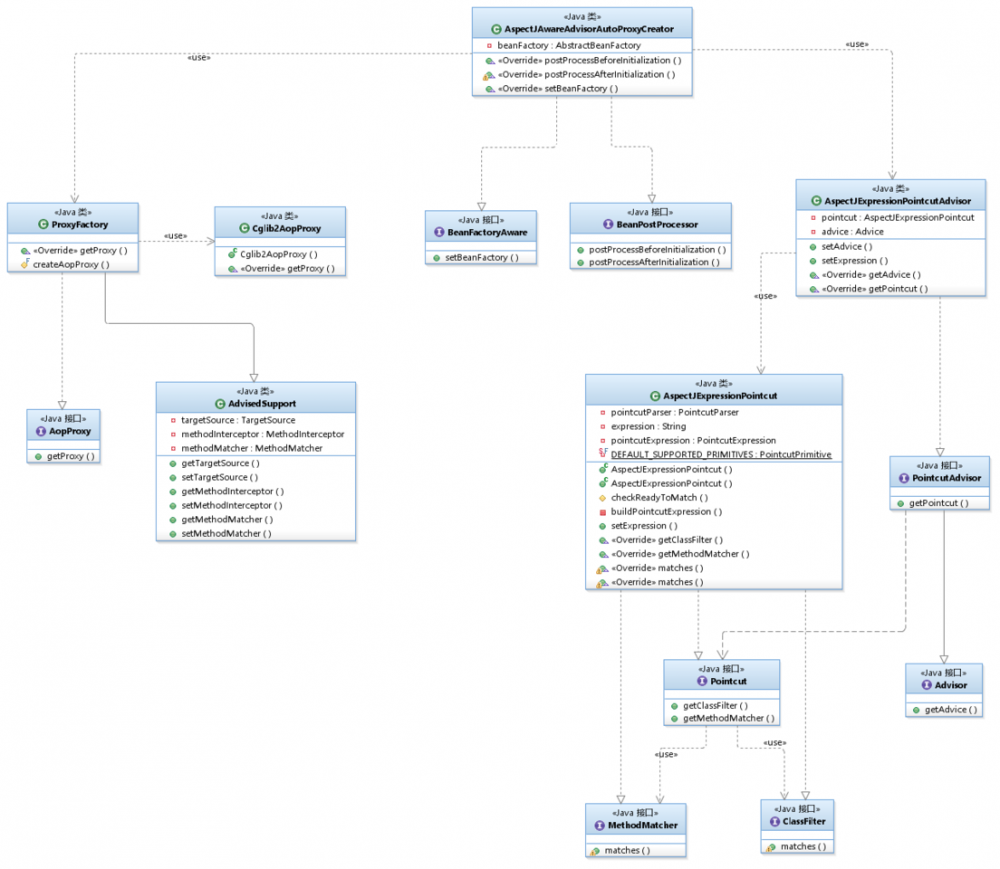
2、使用cglib动态代理
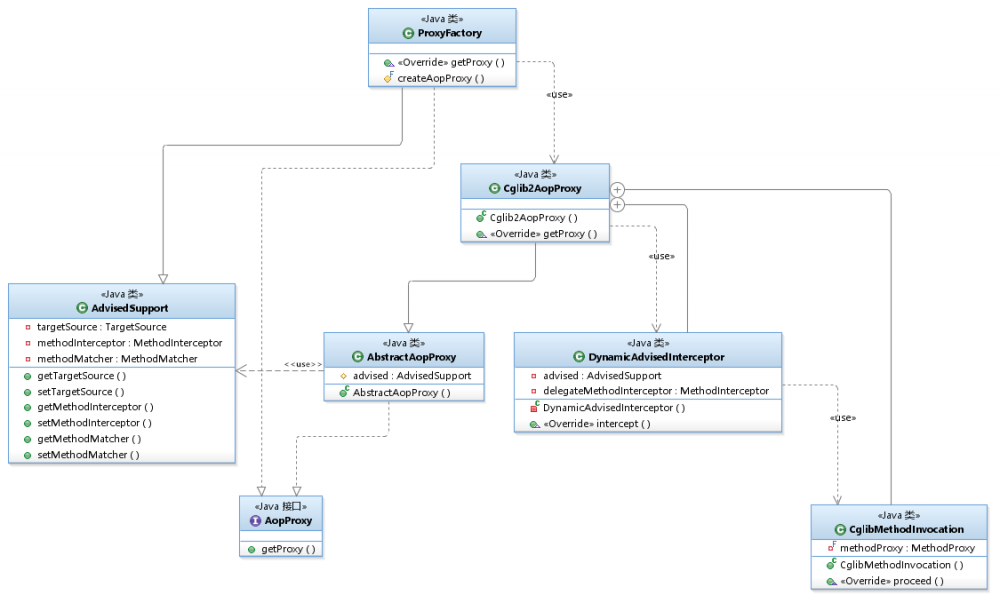
3、两种动态代理
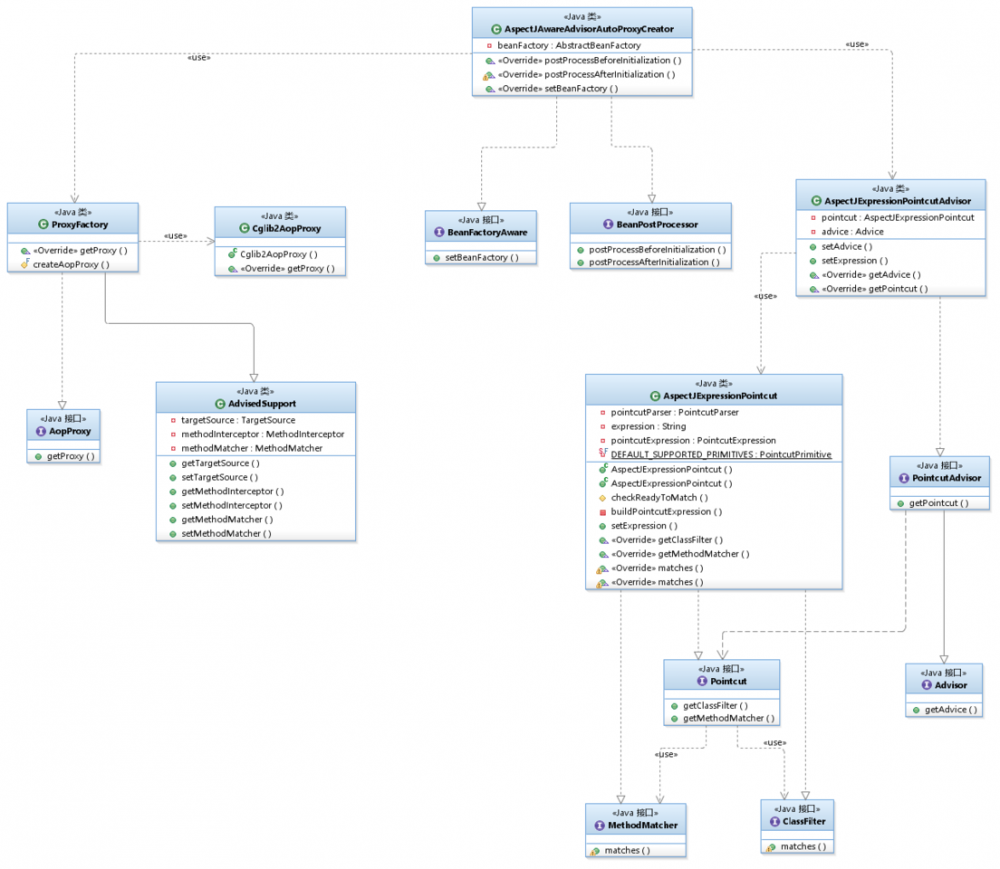











![[HBLOG]公众号](https://www.liuhaihua.cn/img/qrcode_gzh.jpg)

